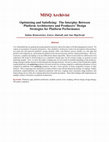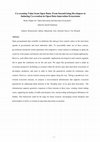Papers by Sabine Brunswicker

Industrial and Corporate Change
In their seminal theory on modularity in design, Baldwin and Clark (2000, Design Rules: The Power... more In their seminal theory on modularity in design, Baldwin and Clark (2000, Design Rules: The Power of Modularity. MIT Press) focus on the macro-level: They show that modularity limits the degree to which changes propagate throughout a complex system, as constituted by how interdependencies among all parts pattern into a nested design structure with shared parts at the top transmitting functionalities via central parts down to the bottom. In this paper, we shift the focus to the microlevel structures of interdependencies that reflect the local decisions of designers with limited rationality. Such decisions relate to five fundamental types of interdependence structures among three parts: the design motifs. Following Baldwin and Clark (2000, Design Rules: The Power of Modularity. MIT Press), we assume that value-seeking designers weigh costs and benefits when creating motifs. We develop a new design motif theory to understand the sources of macro-level modularity. We empirically explore...
Academy of Management Proceedings, 2021
In Open Source Software (OSS) communities, coordination happens based on artifact-mediated intera... more In Open Source Software (OSS) communities, coordination happens based on artifact-mediated interactions among geographically dispersed individuals. Prior literature on OSS and software evolution ar...

SSRN Electronic Journal, 2019
The established stream of literature on design architectures argues that designers should aim for... more The established stream of literature on design architectures argues that designers should aim for modular architecture in order increase the system’s technical performance by lowering the propagation costs of the system’s design: A system with a small stable “core”, a cycle of coupled parts of the system, and a large variable periphery reduce the risk of technical feature and increase opportunity for innovation. However, such a core-periphery view ignores the micro-level dependency structures that emerge in open collaboration when a large number of developers produce a complex technical system at distance, virtually, and outside of formal employment relationships. In this paper, we develop a theory of design network motifs that accounts for the smallest design dependencies in the system that emerge in situ. Informed by the network theoretical concept of a “motif”, we introduce design motifs as the smallest unit of design interdependencies in a system architecture and develop a theory of design network motifs describe each system’s ‘motif fingerprint’ and explains how certain motif patterns affect the performance of a system as a whole. We empirically examine our design network motif theory using architectural data of the Open Stack repository NOVA, consisting of 2359 files and 1545532 lines of code. We extract all potential design network motifs created by 872 developers for 5 years. Our results show that design network motifs offer a new way to explain hidden dependencies in complex system architectures. Surprisingly, it is not just cycling that significantly impact a system’s performance but instead, a “feed-forward loop” motif. Our results contribute to the literature on design architectures and open collaboration more broadly.
Social Science Research Network, Mar 2, 2018

Along with environmental awareness, the interdisciplinary field of eco-feedback has become an act... more Along with environmental awareness, the interdisciplinary field of eco-feedback has become an active research interest in Human Computer Interaction (HCI), Computing, and Sustainable Design. While designers face the challenge of designing complex socio-technical systems (Norman and Stappers 2015), eco-feedback lacks comprehensive theoretical contributions to guide such efforts. This paper followed the PRISMA-P structured review method and reports on mostly empirical papers (N=36) on eco-feedback design from the past decade (2006-2016). The aim was to systematize the emerging field by classifying feedback types according to their impact on end users and identify theoretical grounding. Through our deep inductive engagement with the studies, we present four eco-feedback affordances: (1) Inform for awareness change; (2) Incentivize for motivation change; (3) Educate for behavioral change; and (4) Control for convenience. Current research is corroborating empirical evidence in support of...

2018 IEEE Conference on Visual Analytics Science and Technology (VAST), 2018
Social data charts – visual presentations of quantitative data about peer behaviors – may offer n... more Social data charts – visual presentations of quantitative data about peer behaviors – may offer new means to motivate individuals to participate in group goals. However, to do so these charts need to create a semantic response of ‘unity’ among the chart viewers in order to overcome the problems of social loafing where people act selfishly and undervalue the group’s goal. In this paper, we focus on two properties of social data charts that may affect a viewer’s perceptions of unity: (1) The skewness in the data structure – the statistical distribution of the social data, and (2) the proximity in the visual structure of the chart – the spatial organization of the data points. We performed a controlled perceptual experiment to examine the effect of proximity and skewness on four different semantic facets of perceived group unity: similarity, entitativity, rapport, and centrality. We exposed 179 participants on Amazon Mechanical Turk to different group charts using a 2 x 2 factorial des...

Two-sided platforms are gaining increasing attention in practice and as the subject of IS and man... more Two-sided platforms are gaining increasing attention in practice and as the subject of IS and management research. We explore an assumption of research and practice: that a platform’s architecture needs to be decoupled so that producers can easily mix and match the platform’s design elements (APIs, code libraries, process models, etc.) into apps that perform well competitively, and insulate the platform from skewed outcomes and low market performance. However, in practice, complete decoupling is not just difficult but almost impossible. Based on more than two million runs of an exploratory NK model in which producers use a platform’s design space for the creation of apps, we generate several surprising insights. First, we show that tighter coupling may not necessarily be harmful depending on the producers’ design strategies and the amount of constraints placed on design elements. Second, we observe that if moderate to tightly coupled platforms with optimizing producers focused exclu...
Journal of the Association for Information Science and Technology
IEEE Transactions on Engineering Management

World Scientific Reference on Innovation
Open governmental data available via platforms like data.gov have earned a place in the innovatio... more Open governmental data available via platforms like data.gov have earned a place in the innovation agenda of governments and local authorities alike. To successfully make use of these sources, governments around the world experiment with competitive virtual contests or challenges to ignite the creativity of developers and hackers and motivate them to turn this data into novel digital applications. However, such efforts don't seem to be sustainable. Applications developed in such contests regularly fail to ignite the continuous use by the end users. We argue that governments need to adopt an ecosystem perspective facilitating co-creation within the diverse open data innovation ecosystems of developers, producers, and users in order to foster the generativity needed for continuous value creation. However, various tensions among actors appear along the way. Taking a paradoxical view towards ecosystem tensions, we propose a socio-technical infrastructure that supports ecosystem generativity by addressing latent tensions in the 'breeding zone' of an open data innovation. The infrastructure supports generative responses to these tensions in three ways: creating virtual trading zones, supporting the duality of stable and dynamic roles, and providing technological affordances for fluidity. This framework could set the stage for future research, encouraging system designers and policymakers to foster co-creation in open data innovation ecosystems.
Research-Technology Management
Academy of Management Proceedings

Scientometrics, 2016
Modern science has become collaborative and digital. The Internet has supported the emergence of ... more Modern science has become collaborative and digital. The Internet has supported the emergence of scientific digital platforms that globally connect programmers and users of novel digital scientific products such as scientific interactive software tools. These digital scientific innovations complement traditional text-based products like journal publications. This article is focused on the scientific impact of a platform’s programming community that produces these digital scientific innovations. The article’s main theoretical argument is that beyond an individual’s contribution efforts to these innovations, a new social structure affects his scientific recognition through citations of his tools in text-based publications. Taking a practice theory lens, we introduce the concept of a digital practice structure that emerges from the digital innovation work practice, performed by programmers who jointly work on a tool. This digital practice creates dependence forces among the community members in an analogy to Newton’s gravity concept. Our model represents such dependencies in a spatial autocorrelative model. We empirically estimate this model using data of the programming community of {nanoHUB} in which 477 nanotechnology tool programmers have contributed more than 715 million lines of code. Our results show that a programmer’s contributions to digital innovations may have positive effects, while the digital practice structure creates negative dependency effects. Colloquially speaking, being surrounded by star performers can be harmful. Our findings suggest that modeling scientific impact needs to account for a scientist’s contribution to programming communities that produce digital scientific innovations and the digital work structures in which these contributions are embedded.

SSRN Electronic Journal, 2000
This paper provides an overview of the main perspectives and themes emerging in research on open ... more This paper provides an overview of the main perspectives and themes emerging in research on open innovation. The paper is the result of a collaborative process among several open innovation scholars-having a common basis in the recurrent Professional Development Workshop (PDW) on "Researching Open Innovation" at the Annual Meeting of the Academy of Management. In this paper, we present opportunities for future research on open innovation, organized at different levels of analysis. We discuss some of the contingencies at these different levels, and argue that future research needs to study open innovationoriginally an organizational-level phenomenon-across multiple levels of analysis. While our integrative framework allows comparing, contrasting, and integrating different perspectives at different levels of analysis, further theorizing will be needed to advance open innovation research. On this basis, we propose some new research categories as well as questions for future research-particularly those that span across research domains that have so far developed in isolation.

International Journal of Technology Intelligence and Planning, Mar 20, 2015
The burgeoning discussion in open and collaborative innovation has revitalised fi rms' interest i... more The burgeoning discussion in open and collaborative innovation has revitalised fi rms' interest in purposive infl ows and outfl ows of knowledge. This questions our understanding of 'explorative innovation' and the role of technologies in explorative innovation search. This paper aims to enhance our conceptual understanding of 'explorative' innovation strategies. On the basis of a systematic literature review, we synthesise the existing literature on explorative innovation. We identify six groups of conceptualisations that refl ect the diverse perspective towards explorative innovation. These groups differ in terms of the level of analysis, the dominating theoretical perspectives, the underlying dimensions describing how fi rms explore and search, and the relevance of external and internal conditioning factors. Overall, we found that the role of technology in explorative search varies, and has slightly changed over time. We propose a multidimensional perspective towards exploration. We highlight that technologies may serve a range of functions in the fi rm's business model.
Uploads
Papers by Sabine Brunswicker